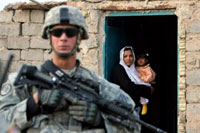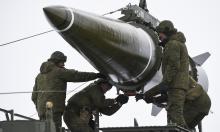The New Face of the Human Terrain System
by John Stanton

US Army Human Terrain System (HTS) principals recently produced a number of briefings adding up to a total of 133-pages of MS PowerPoint slides. For convenience sake here, we’ll use the title of the first presentation titled The Future: Training Directorate Executive Overview, 08 January 2010 (The Future) as the overall title for the series. The presentations contain a dizzying array of information, mostly in living color.
They are audacious and excellent documents whose purpose seems to be to convince command and funding sources that HTS principals have been working since at least 2008 to improve recruiting practices (rigid check of qualifications), training methodologies (going Socratic, modular and phased) and logistics practices (housing, deployment, transport, move to Kansas City).
Once past the hypnotic affects of the 133 slides that induce a “this is great” feeling, the realization comes that the same people who destroyed the US Army program concept in the first place are the same ones that now claim they can reconstruct it and expand HTS operations to all combatant commands.
Montgomery Clough and Steve Fondacaro still remain at the program’s helm in spite of two year’s worth of allegations--from former and current HTS employees--that fraud, waste and abuse have been common place throughout the life of the HTS. Further, the substance of The Future is early-collegiate, not professional military/academic pedagogy. Financial figures are presented with no work breakdown structure/allocation. And worse, there is no mention of any academic/university review of the social science effort. This is troublesome given that management’s experience in the field is limited. In short, the effort seems somewhat disingenuous.
There is Very Little Accountability
Before getting into The Future, other developments of significance have taken place over the past month with Clough and Fondacaro in charge. Scott Wilson a social scientist on a HTT working in Kandahar, was wounded and evacuated back to the USA. His condition is unknown at this time. Georgia Tech, according to some, may lose its contract ($7.2 million) to McNeil Technologies, an aggressive contractor that boasts on its website about the influence of its Board of Directors.
According to one observer, “It sounds like HTS will still have to prove itself for a while especially in Afghanistan . That said, because of past problems with BAE, the US Army already appears to be taking greater responsibility for HTS training -- the design and how it's managed. It certainly needs to be evaluated, because there is very little accountability. There is an enormous amount of data being collected, though. My impression is that the brigade commanders find the HTS stuff most useful when it turns into operational or even tactical intelligence for them. That would be their natural inclination. Whether this will form part of a serious CORDS-style rural pacification program is anyone's guess. I think that's the intent, certainly, and could be a source of great controversy. But the longer term justification is for the post-conflict stabilization and reconstruction phase, and that may help sell it to Congress more convincingly Not that most of Congress, to say nothing of Obama and his team, seems averse to a revival of counterinsurgency at this point.
On that note, the HTS Independent Assessment that was to be conducted by the House Armed Services Committee over a six month time frame may now have to be completed in one or two months due to the requirements of the Quadrennial Defense Review.
Crawl-Walk-Run: Why Not When the Program Started?
According to the The Future, “the HTS Curriculum Design OPT conducts collaborative planning and curriculum design on 25 January 2010, at Ft Leavenworth, KS, in order to facilitate the development and implementation of a curriculum that prepares and certifies candidates for successful service as members of deployed HTS teams.”
HTS has adopted an 28 part integrated modular concept for training with three distinct phases. “Through Socratic methods, the Crawl Phase teaches and trains the individual knowledge, skills and attributes each student must master in order to perform as a Human Terrain Team member.
The Walk Phase bridges individual and collective skills. This phase consists of case studies driving small group interaction culminating in a series of vignette driven practical exercises that enable teaching, coaching and training team performance dynamics.
The Run Phase bridges collective skills and the operational environment. This phase consists of a local Capability Exercise (CAPEX), followed by participation in a CTC rotation where students perform collective tasks in support of a BCT under simulated theater-like conditions.”
Students must also be adept at using the feared MS PowerPoint program to report on efforts/findings in each phase. For example, a section titled Social Science Concept Instruction with Practical Exercises requires that each individual build a PowerPoint on the social structure in their hometown, 2 hours.” Another section, “Final Product Instruction with Practical Exercises requires that: sub-groups of 5 produce a Socio-cultural Situational Awareness PowerPoint and deliver it to the class, 3 hours.”
$16,870 for Each Student: Finally Some Financials
The Future contains some interesting financials worth noting. Some highlights are listed below and are taken directly from The Future. Annual costs under the BAE contract (being phased out) for student lodging, housing and transport were approximately $11.8 million (US) per year.
By 1 April 2010, the HTS Consolidated Training Directorate will be moving to 7310 Tiffany Springs Parkway, Circle Building IV in Kansas City, Missouri. The proposed student housing complex will be at The Crossing at Barry Road, 7831 NW Roadridge Road, Kansas City, Missouri, 64151.
The move to Kansas City, a more expensive location, will evidently save close to $3.8 million. Part of that savings comes from contracting with Direct Housing, Inc under GSA Schedule 48. Further savings on build-out for the new HTS home is realized through DA PAM 420-11 (Oct 1994) p. 5, pp C: Construction: Any work done that converts or modifies space, changing the purpose of utilization is considered “construction” for fiscal purposes. Following this Plan overcomes this MilCon requirement by a Lease that contains a build-to-suit single-tenant agreement.
The average amount of time a student is in the training base is 6 months. (5 months are spent as civilian contractors and 1 month as a DAC for a total of 110 training days.) Not including student salaries, the training budget is $13.5 million a year. (Included is $5 million for DMLI’s Weston Resolve, ($455k per exercise times 11 exercises a year equals $5.005 million), and $2 million for CareerStones’s Team Dynamics Training.) Class sizes are projected at 35 students per cycle. Given 11 training cycles, this equates to 385 graduates a year. Not including Weston Resolve , CareerStone and student salaries, the training budget is $6,495,000. This figure divided by 385 equates to $16,870 to graduate one student.
At present, $500,000 is budgeted for anticipated operations and maintenance costs for computer site licenses (JMESL); computer hardware repair and replacement; software and routine GSA office supplies. This figure is a placeholder. As the OPT finalizes future curriculum requirements, this estimate will be refined.
Annually a civilian contracted TL or SS make $100k, a RM makes $90k, and a HTA makes $80k. (These salaries are estimated as the exact figures are not available for this informal analysis.) This equates to approximately $8300, $7500, and $6600 a month respectively. Given the above, the 5 month salary paid to these students while in training is $1,816,667. Given the $1,816,667 paid in contractor student salaries multiplied by 75% for employer overhead expenses, the Legacy training approach incurs an additional cost of $1,382,500. Contractor student per-diem is $931,500. This includes $135 a day (Hotel $70 / Rental Car $45 / Gas $10) x 30 days a month x 5 months x 46 students For the one month these 46 students are paid as DA Civilians, the salary costs which include locality pay are $382,333. This figure includes the number and type by pay scale.
The annual operating costs for the Exercise Division are $10,235,500.
DA Civilians (DAC) Costs. The Exercise Division will employ 16 veteran Team Leaders, 16 Social Scientists, 4 Research Managers, and 10 Human Terrain Analysts totaling 46 DAC personnel. Calculated at the 2009 pay scales and locality pay of 13.86%, the annual cost for Exercise Division DACs is $4,588,000.
Contractor Costs. The Exercise Division will employ 30 ex-military contract personnel who are experts in planning and executing collective training. Total base salary costs are projected to be $2,666,000 a year. Include $1,999,500 in overhead and the projected annual contractor cost is $4,665,500 a year. The following methodology was used to develop a contractor salary cost estimate.
Assuming the Exercise Division was a military organization, what would be the rank / grade required to perform the duties as outlined in the Exercise Division position descriptions? To answer this question, TRADOC’s Battle Command Training Program was used as a model. The BCTP exercise planning, coordination, and execution functions closely parallel the Exercise Division. Therefore, the military rank structure associated with the BCTP TDA was proposed to answer the above question. Analysis then proceeded to a comparison of military rank to the corresponding DAC pay scales. Using the 2009 DA Civilian pay scales, competitive contractor salaries were then developed as the basis for projecting this cost.
Troubles in the SSRA World
According to a US Army posture statement, Social Science Research and Analysis (SSRA) personnel provide operationally relevant, empirical, qualitative, and quantitative social science research conducted in the area of operations, generally in support of HTAT and operational-level commands. On July 1, 2008, HTS deployed Social Science Research and Analysis (SSRA) capability to Afghanistan in support of the theatre and deployed HTTs. On November 1, 2008, HTS deployed SSRA capability to Iraq.
Are SSRA personnel doing what they are contracted to do? Who manages their efforts?
Observers had this to say about SSRA’s.
“SSRA’s contractors do not work; i.e., they have an office in Kabul where they might sit during office hours but they do not conduct research themselves, or task sub-contractors to conduct surveys for them. With the exception of one product, no one could remember an SSRA product over the preceding ten months. The one product which was produced was described as “weak” and “basic stuff everyone knows.” There was criticism of SSRA as a body which (paraphrased) ‘could not be up-to-date on AF because they (sic) never go to the field (as the HTT’s do).’ No one could remember a visit by an SSRA contractor to a FOB or COP in his/her time in AF, or a mention in a briefing about SSRA having a person/team in the AO and an Army unit having to support that person/team in the field. The claimed ability of SSRA to conduct surveys of the civilian population in AF has to be questioned.
The SSRA contract apparently pays SSRA a flat annual fee for services rendered. There is no stipulated number of products per year to be produced. SSRA apparently does not have to solicit research/survey projects from HTS elements, or suggest them to HTS, IOT be paid. The amount HTS has paid to SSRA over the past few years has to be in the millions of dollars.”
Lastly, comes this comment from the field. “SSRA Qualitative Assessments are at this point more dangerous than they are useful. They are dangerous because people who don’t understand research (and I include most people reading the assessments in this number) will draw inferences concerning the whole population that are unwarranted.
John Stanton
Subscribe to Pravda.Ru Telegram channel, Facebook, RSS!





